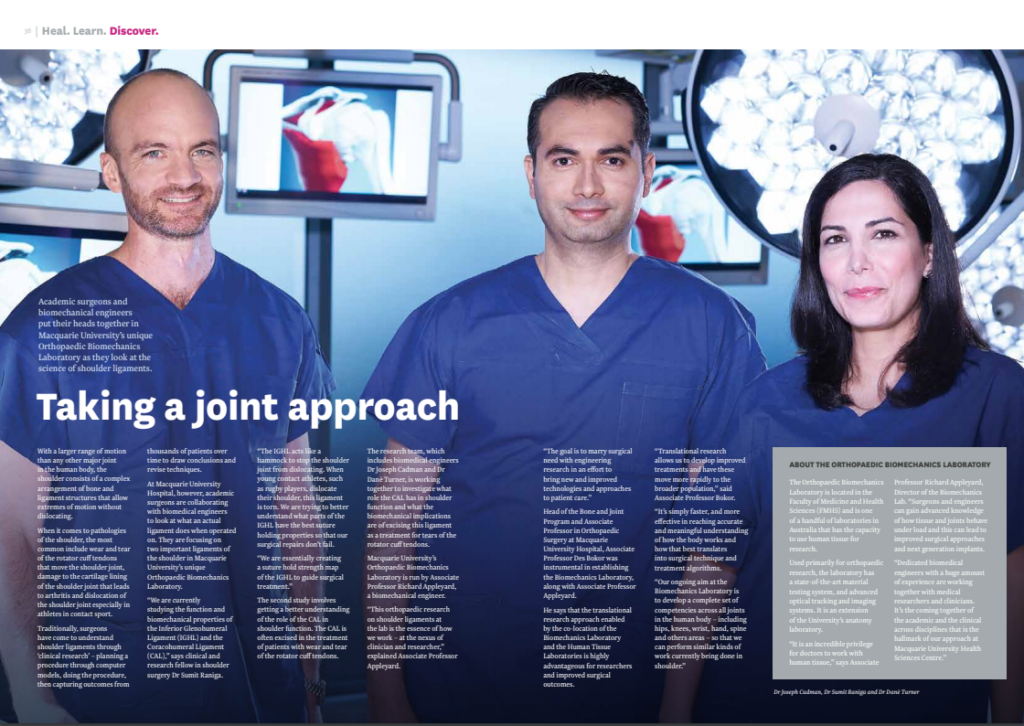With a larger range of motion than any other major joint in the human body, the shoulder consists of a complex arrangement of bone and ligament structures that allow extremes of motion without dislocating.
When it comes to pathologies of the shoulder, the most common include wear and tear of the rotator cuff tendons that move the shoulder joint, damage to the cartilage lining of the shoulder joint that leads to arthritis and dislocation of the shoulder joint especially in athletes in contact sport.
Traditionally, surgeons have come to understand shoulder ligaments through ‘clinical research’ – planning a procedure through computer models, doing the procedure, then capturing outcomes from thousands of patients over time to draw conclusions and revise techniques.
At Macquarie University Hospital, however, academic surgeons are collaborating with biomedical engineers to look at what an actual ligament does when operated on. They are focusing on two important ligaments of the shoulder in Macquarie University’s unique Orthopaedic Biomechanics Laboratory.
“We are currently studying the function and biomechanical properties of the Inferior Glenohumeral Ligament (IGHL) and the Coracohumeral Ligament (CAL),” says clinical and research fellow in shoulder surgery Dr Sumit Raniga.
“The IGHL acts like a hammock to stop the shoulder joint from dislocating. When young contact athletes, such as rugby players, dislocate their shoulder, this ligament is torn. We are trying to better understand what parts of the IGHL have the best suture holding properties so that our surgical repairs don’t fail.
“We are essentially creating a suture hold strength map of the IGHL to guide surgical treatment.”
The second study involves getting a better understanding of the role of the CAL in shoulder function. The CAL is often excised in the treatment of patients with wear and tear of the rotator cuff tendons.
The research team, which includes biomedical engineers Dr Joseph Cadman and Dr Danè Turner, is working together to investigate what role the CAL has in shoulder function and what the biomechanical implications are of excising this ligament as a treatment for tears of the rotator cuff tendons.
Macquarie University’s Orthopaedic Biomechanics Laboratory is run by Associate Professor Richard Appleyard, a biomechanical engineer.
“This orthopaedic research on shoulder ligaments at the lab is the essence of how we work – at the nexus of clinician and researcher,” explained Associate Professor Appleyard.
“The goal is to marry surgical need with engineering research in an effort to bring new and improved technologies and approaches to patient care.”
Head of the Bone and Joint Program and Associate Professor in Orthopaedic Surgery at Macquarie University Hospital, Associate Professor Des Bokor was instrumental in establishing the Biomechanics Laboratory, along with Associate Professor Appleyard.
He says that the translational research approach enabled by the co-location of the Biomechanics Laboratory and the Human Tissue Laboratories is highly advantageous for researchers and improved surgical outcomes.
“Translational research allows us to develop improved treatments and have these move more rapidly to the broader population,” said Associate Professor Bokor.
“It’s simply faster, and more effective in reaching accurate and meaningful understanding of how the body works and how that best translates into surgical technique and treatment algorithms.
“Our ongoing aim at the Biomechanics Laboratory is to develop a complete set of competencies across all joints in the human body – including hips, knees, wrist, hand, spine and others areas – so that we can perform similar kinds of work currently being done in shoulder.
ABOUT THE ORTHOPAEDIC BIOMECHANICS LABORATORY
The Orthopaedic Biomechanics Laboratory is located in the Faculty of Medicine and Health Sciences (FMHS) and is one of a handful of laboratories in Australia that has the capacity to use human tissue for research. Used primarily for orthopaedic research, the laboratory has a state-of-the-art material testing system, and advanced optical tracking and imaging systems. It is an extension of the University’s anatomy laboratory.
“It is an incredible privilege for doctors to work with human tissue,” says Associate Professor Richard Appleyard, Director of the Biomechanics Lab.
“Surgeons and engineers can gain advanced knowledge of how tissue and joints behave under load and this can lead to improved surgical approaches and next generation implants. “Dedicated biomedical engineers with a huge amount of experience are working together with medical researchers and clinicians. It’s the coming together of the academic and the clinical across disciplines that is the hallmark of our approach at Macquarie University Health Sciences Centre.”
MQ Health Shoulder and Elbow Clinic,
Suite 303, Level 3,
2 Technology Place,
Macquarie University
NSW 2109
Australia

